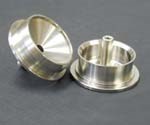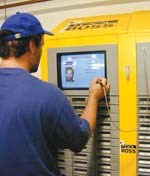New Borders For Swiss-Type Turning
The traditional niche may be too narrow. This shop uses sliding-headstock lathes for jobs that wouldn't normally be run on this type of machine.
Share




Swissline Precision Manufacturing is a job shop with nearly 30 CNC machines, but the shop is missing the most basic job shop machine tool of all. At Swissline, there are no machining centers.
The president and owner, David Chenevert, disdains the sort of work that screw machine shops and other users of automatic machines refer to as "secondary operations"—work such as milling and drilling performed on a separate machine after a high production lathe has done just part of the cutting. Mr. Chenevert prefers to do all of the machining on the lathe. His machine of choice is a CNC Swiss-type lathe—a sliding-headstock machine with an opposing subspindle and rotary-tool capability. Swissline has 23 such machines.
The shop is thriving. In spite of the general downturn, this shop in Cumberland, Rhode Island, has seen little decline in its own business. The machines are busy, even though the shop limits them to work that requires no complex machining on a follow-up machine. A principal reason why the machines are busy is the marketing effort of the shop owner. He aggressively pursues work outside of what is traditional for Swiss-type lathes, and outside of what is typical for the high-volume automatic machine shops that are the most familiar with these machines.
A Swiss-type lathe is a bar-fed machine that achieves Z-axis motion by feeding the work through the headstock instead of feeding the tool. The tool remains close to the bushing supporting the part. As a result, the cut is consistently stable across the part's length. Typical jobs for Swiss-type machines are long, slender parts that would deflect if supported by a center on a standard lathe. Also typical for CNC Swiss-types are complex, tiny parts that not only are prone to deflection, but also would be problematic to set up on multiple machines.
Swissline does run parts such as these. However, just as routinely, the shop also runs parts such as the ones shown at left—parts that would typically be run using a basic chucker lathe, perhaps followed by a VMC.
In addition, the shop takes on small-quantity jobs. Fifty-piece runs are common, and a 15-piece job was run just before this article was written. Even one-piece orders come in from time to time. In making the shop receptive to a variety of part shapes and a variety of order quantities, Mr. Chenevert has pushed the Swiss-types beyond their traditional niche and moved his company beyond its automatic machining roots.
Two Lathes Per Year
Swissline relied on cam-driven Swiss-type machines when Mr. Chenevert bought into the business in 1985. "Back then, we used secondary operations on everything," he says. Common features such as cross-holes and milled flats couldn't be produced economically on the cam-driven machines. As a result, "we had batches of half-finished blanks sitting all over the shop," all waiting for follow-up machining.
Before coming to Swissline, Mr. Chenevert worked in a screw machine shop that primarily used cam-driven multi-spindle machines. He still thinks in the terms of these lathes, he says. In his mind, a multi-spindle automatic defines the level of productivity that he needs to beat today using a CNC Swiss-type machine. A multi-spindle machine's advantage in this contest is straightforward—it lets multiple spindles work on the same part simultaneously. But a CNC Swiss-type can overcome the need for secondary operations.
Mr. Chenevert oversaw the purchase of Swissline's first CNC Swiss-type the same year he bought into the shop. Two years later, he changed his supplier for this type of machine, buying his first CNC Swiss-type from Tsugami. This builder is represented in the United States by Rem Sales (East Granby, Connecticut), and Mr. Chenevert soon told the distributor that he planned to buy two more such machines per year. The Rem Sales representative was dubious. Fifteen years later, however, Swissline has purchased 30 of the Swiss-type machines. The oldest of these machines have been replaced by higher-function models, but most of the machines are still in daily use.
One very useful avenue for finding work for these lathes has been job shop shows, Mr. Chenevert says. The potential customers he meets by exhibiting at these shows often don't know what a Swiss-type machine is. Those who do tend to have an inaccurate perception about what the machines can do.
"I ask them what parts they're running, and what their problems are," he says. Certain machining problems are red flags, alerting him to a job that a CNC Swiss-type could run more effectively. These problems include concentricity error, milling location error, deburring problems and unacceptable finish.
"For a typical job where one of our Swiss-type machines replaces some multiple-setup process, we can reduce labor, increase efficiency and improve tolerances—all at once," he says.
But the shop doesn't realize these benefits for just any part. Swissline may be challenging the perceived limitations of a Swiss-type machine, but this machine type does have certain limitations built in that are very real.
Working Small
One obvious limitation of a Swiss-type machine relates to work diameter. Tsugami offers Swiss-types accommodating work up to 1.5 inch in diameter, and this is very large for a Swiss-type machine. Swissline bought a fixed-headstock CNC lathe just so it could have the capacity to take on parts larger than this.
Horsepower is another limitation. A Swiss-type with 15 hp for the main spindle is a powerful machine. The much smaller rotary tool spindles are light enough that using them to machine hard metals can be a challenge. In fact, the need to drill holes in hard workpieces represents a common reason why Swissline does resort to secondary operations. In these cases, the work is done on a simple milling and drilling machine, often a manual one. (Another example of when Swissline does resort to secondary work is when the fixed-headstock lathe is used to cut the part-off nub left behind by a Swiss-type model that lacks a subspindle. In other words, the shop uses secondary operations only for very simple features, not complex ones.)
And yet, even though horsepower may be limited compared to other types of lathes, the availability of 15 hp machines represents a major improvement over the previous limits of what CNC Swiss-types could do. These machines have steadily improved, and Mr. Chenevert has watched the evolution. He notes that the machines now offer high speed CNCs, linear ways, direct-drive spindles and servo control over the vertical position of the turret. None of these features was available when he was starting out.
As a result of these and other improvements, he says, Swiss-types today perform effectively across a much broader variety of work than they are usually given credit for. They can generate a range of complex features. And they're not limited to aluminum and brass—a common misperception.
"We run 4140 steel all the time," he says. "We run Inconel."
The machines are not particular about the production quantity, either. In addition to large runs, Mr. Chenevert uses the machines to run small batches, even prototype parts. To handle short-run work effectively, the shop relies on employees who are sufficiently practiced and equipped that they can initiate a new job at any time. (See the companion article in the shaded box.)
Recently, a ten-piece order for a prototype part was placed by the customer, then programmed, machined and shipped by Swissline, all in the same day. Mr. Chenevert says, "I wouldn't want to make my living off of jobs like this, but it helps us that the customers know we can do this kind of work when they need it."
For more information about Tsugami CNC Swiss-type lathes from Rem Sales, call (860) 653-0071.
For more information about CncGcoder from RBR Machine Tools, call (630) 971-8729.
For more information about tool dispensing systems from Kennametal, call (724) 539-5330.
Related Content
Industry Analysis: Machining Semiconductor Components
With many machine shops anticipating long-term growth in demand from the semiconductor industry, it is worth the time to heed the advice of manufacturers who have already been servicing this end-market for years.
Read MoreControlling Extreme Cutting Conditions in Large-Part Machining
Newly patented technologies for controlling chatter and vibration during milling, turning and boring operations promise to drastically reduce production time and increase machining performance.
Read More5 Tips for Running a Profitable Aerospace Shop
Aerospace machining is a demanding and competitive sector of manufacturing, but this shop demonstrates five ways to find aerospace success.
Read MoreSwiss-Type Control Uses CNC Data to Improve Efficiency
Advanced controls for Swiss-type CNC lathes uses machine data to prevent tool collisions, saving setup time and scrap costs.
Read MoreRead Next
Registration Now Open for the Precision Machining Technology Show (PMTS) 2025
The precision machining industry’s premier event returns to Cleveland, OH, April 1-3.
Read MoreBuilding Out a Foundation for Student Machinists
Autodesk and Haas have teamed up to produce an introductory course for students that covers the basics of CAD, CAM and CNC while providing them with a portfolio part.
Read More5 Rules of Thumb for Buying CNC Machine Tools
Use these tips to carefully plan your machine tool purchases and to avoid regretting your decision later.
Read More


























.jpg;maxWidth=300;quality=90)











